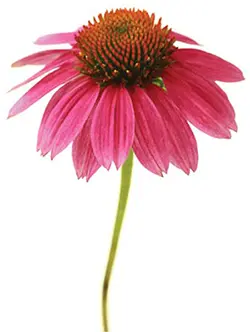
Exploring the Origins
Echinacea, part of the daisy family, is known for its distinctive coneflowers with pink or purple petals. Originating in North America, its name is derived from the Latin ‘echinus’, alluding to its sea urchin-like seed head.
Historical Significance and Lore
Traditionally used by Plains Native Americans for pain relief and treating various ailments, Echinacea was a prevalent medicinal plant in the United States until the advent of antibiotics. The Lakota people continue to harvest it for its healing properties.
Healing Uses
Echinacea is celebrated for enhancing white blood cell production and stimulating the immune system. It has anti-carcinogenic, antibiotic, and anti-inflammatory qualities. Useful in combating infections, colds, and flu, it can be consumed as tea or chewed in root form. Applied as a tea-soaked compress, it eases skin inflammations, burns, and insect bites. Echinacea essential oil, used in massages, relieves tension in the head, neck, and shoulders.
Magical Uses
Echinacea, when grown around the house, is believed to attract prosperity and protect against suffering. It serves as an offering to spirits, enhances spell power, and is burned as incense in cleansing rituals.
Personal and Spiritual Growth
Echinacea aids in the awakening and integration of the true self, particularly beneficial during major life transitions. It brings strength, stamina, and a sense of inner harmony, balancing mind and body for holistic well-being.
